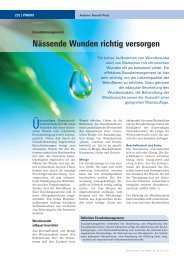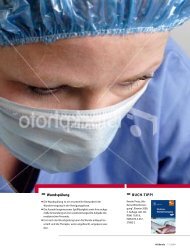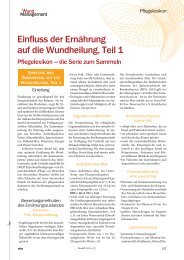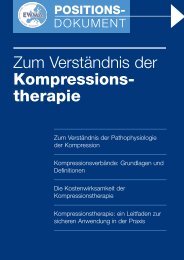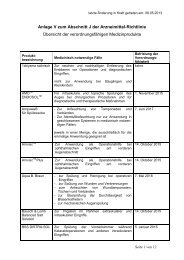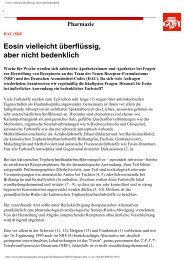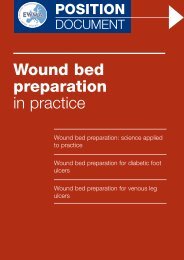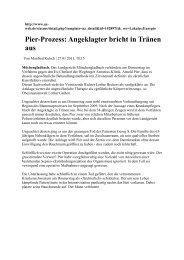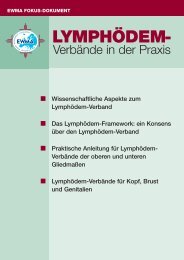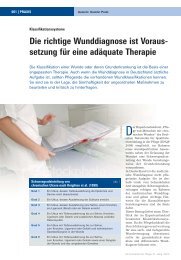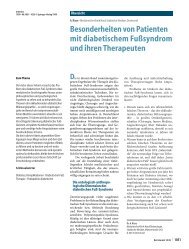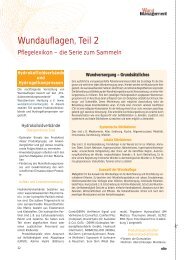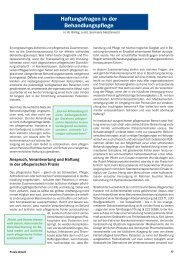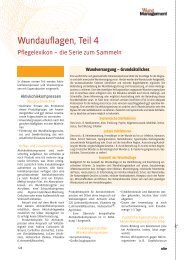Minimising pain at wound dressing-related procedures A ... - Less Pain
Minimising pain at wound dressing-related procedures A ... - Less Pain
Minimising pain at wound dressing-related procedures A ... - Less Pain
Create successful ePaper yourself
Turn your PDF publications into a flip-book with our unique Google optimized e-Paper software.
PRINCIPLES OF<br />
BEST PRACTICE<br />
U N<br />
W O R L D<br />
I O N<br />
O F<br />
W O U N D<br />
I N G<br />
H E A L<br />
A World Union of Wound Healing Societies’ Initi<strong>at</strong>ive<br />
I E S<br />
I E T<br />
S O C<br />
<strong>Minimising</strong> <strong>pain</strong> <strong>at</strong> <strong>wound</strong><br />
<strong>dressing</strong>-rel<strong>at</strong>ed <strong>procedures</strong><br />
A consensus document
1. European Wound<br />
Management Associ<strong>at</strong>ion.<br />
Position document: <strong>Pain</strong> <strong>at</strong><br />
<strong>wound</strong> <strong>dressing</strong> changes.<br />
London: MEP Ltd, 2002.<br />
Available from<br />
www.ewma.org<br />
2. Reddy M, Kohr R, Queen<br />
D, Keast D, Sibbald G.<br />
Practical tre<strong>at</strong>ment of<br />
<strong>wound</strong> <strong>pain</strong> and trauma: a<br />
p<strong>at</strong>ient-centred approach.<br />
Ostomy Wound<br />
Management 2003; 49 (4A<br />
Suppl): 2–15.<br />
3. Best practice: minimising<br />
<strong>pain</strong> <strong>at</strong> <strong>wound</strong> <strong>dressing</strong><br />
changes. Summary of the<br />
proceedings of a meeting<br />
of key opinion leaders.<br />
Amsterdam, 23–24<br />
September 2003.<br />
FOREWORD<br />
This guide is a World Union of Wound Healing Societies’ educ<strong>at</strong>ional initi<strong>at</strong>ive. It has<br />
been inspired by two seminal documents: the European Wound Management<br />
Associ<strong>at</strong>ion (EWMA) position document on ‘<strong>Pain</strong> <strong>at</strong> <strong>wound</strong> <strong>dressing</strong> changes’ 1 and a<br />
supplement to Ostomy Wound Management on ‘Practical tre<strong>at</strong>ment of <strong>wound</strong> <strong>pain</strong><br />
and trauma: a p<strong>at</strong>ient-centred approach’ 2 . As an intern<strong>at</strong>ional educ<strong>at</strong>ional initi<strong>at</strong>ive,<br />
this document is aimed <strong>at</strong> anyone involved in <strong>dressing</strong>-rel<strong>at</strong>ed <strong>procedures</strong> anywhere<br />
in the world.<br />
The principles presented are based on st<strong>at</strong>ements from the two documents<br />
mentioned above and the consensus opinion of an intern<strong>at</strong>ional expert working group<br />
(see below) 3 . For the concept of best practice to make a real difference to p<strong>at</strong>ient care,<br />
clinicians should adopt these recommend<strong>at</strong>ions and share them with colleagues,<br />
p<strong>at</strong>ients and carers.<br />
Professor Keith Harding<br />
MANAGING EDITOR:<br />
Suzie Calne<br />
EDITORIAL PROJECT<br />
MANAGER:<br />
K<strong>at</strong>hy Day<br />
EDITORIAL ADVISOR:<br />
Ray Pediani<br />
ASSISTANT EDITOR/<br />
LAYOUT:<br />
K<strong>at</strong>hy Day<br />
DESIGNER:<br />
Jane Walker<br />
PRINTED BY:<br />
Viking Print Services Ltd<br />
FOREIGN TRANSLATIONS:<br />
Alden Transl<strong>at</strong>ions (UK)<br />
PUBLISHING DIRECTOR:<br />
Jane Jones<br />
PUBLISHED BY:<br />
Medical Educ<strong>at</strong>ion Partnership<br />
Ltd, 53 Hargrave Road<br />
London N19 5SH<br />
Tel: 020 7561 5400<br />
Fax: 020 7561 5401<br />
Email: info@mepltd.co.uk<br />
Web: www.mepltd.co.uk<br />
© MEP Ltd 2004<br />
Supported by an educ<strong>at</strong>ional<br />
grant from Mölnlycke<br />
Health Care.<br />
The views expressed in this<br />
document do not necessarily<br />
reflect those of Mölnlycke<br />
Health Care.<br />
EXPERT WORKING GROUP<br />
Michelle Briggs, Leeds University (UK)<br />
Frank D Ferris, San Diego Hospice & Palli<strong>at</strong>ive Care (US)<br />
Chris Glynn, Churchill Hospital, Oxford (UK)<br />
Keith Harding, University of Wales College of Medicine, Cardiff (UK)<br />
Deborah Hofman, Churchill Hospital, Oxford (UK)<br />
Helen Hollinworth, Suffolk College, Ipswich (UK)<br />
Diane L Krasner, Rest Haven, York (US)<br />
Christina Lindholm, Karolinska University Hospital, Stockholm (Sweden)<br />
Christine Moff<strong>at</strong>t, CRICP, Thames Valley University, London (UK)<br />
P<strong>at</strong>ricia Price, University of Wales College of Medicine, Cardiff (UK)<br />
Marco Romanelli, University of Pisa (Italy)<br />
Gary Sibbald, University of Toronto (Canada)<br />
Mike Stacey, University of Western Australia (Aus)<br />
Luc Téot, University Hospital Montpellier (France)<br />
WORLD UNION OF WOUND HEALING SOCIETIES<br />
Secretari<strong>at</strong>: MF Congrès, 8 rue Tronchet, 75008 Paris, France<br />
Tel: 00 33 1 40 07 11 21<br />
Fax: 00 33 1 40 07 10 94<br />
Web: www.wuwhs.org<br />
How to cite this document: Principles of best practice: <strong>Minimising</strong> <strong>pain</strong> <strong>at</strong> <strong>wound</strong> <strong>dressing</strong>-rel<strong>at</strong>ed<br />
<strong>procedures</strong>. A consensus document. London: MEP Ltd, 2004.
PRINCIPLES OF BEST PRACTICE<br />
Unresolved <strong>pain</strong> neg<strong>at</strong>ively affects <strong>wound</strong> healing and has an impact on quality of life. <strong>Pain</strong> <strong>at</strong><br />
<strong>wound</strong> <strong>dressing</strong>-rel<strong>at</strong>ed <strong>procedures</strong> can be managed by a combin<strong>at</strong>ion of accur<strong>at</strong>e<br />
assessment, suitable <strong>dressing</strong> choices, skilled <strong>wound</strong> management and individualised<br />
analgesic regimens. For therapeutic as well as humanitarian reasons it is vital th<strong>at</strong> clinicians<br />
know how to assess, evalu<strong>at</strong>e and manage <strong>pain</strong>.<br />
Having a basic understanding of <strong>pain</strong> physiology will help anyone involved in a <strong>wound</strong><br />
<strong>dressing</strong>-rel<strong>at</strong>ed procedure to understand the p<strong>at</strong>ient’s <strong>pain</strong> experience.<br />
It is fundamental to appreci<strong>at</strong>e th<strong>at</strong> <strong>pain</strong> from <strong>wound</strong>s is multidimensional, and the p<strong>at</strong>ient’s<br />
psychosocial environment will influence and impact on the physiological experience of <strong>pain</strong>.<br />
The Intern<strong>at</strong>ional Associ<strong>at</strong>ion for the Study of <strong>Pain</strong> defines <strong>pain</strong> as “an unpleasant sensory and<br />
emotional experience associ<strong>at</strong>ed with actual or potential tissue damage, or described in terms<br />
of such damage” (www.iasp-<strong>pain</strong>.org).<br />
UNDERSTANDING TYPES OF PAIN<br />
There are two types of <strong>pain</strong>: nociceptive <strong>pain</strong> and neurop<strong>at</strong>hic <strong>pain</strong>. Nociceptive <strong>pain</strong> may be<br />
defined as an appropri<strong>at</strong>e physiological response to a <strong>pain</strong>ful stimulus. It may involve acute or<br />
chronic inflamm<strong>at</strong>ion. Acute nociceptive <strong>pain</strong> occurs as a result of tissue damage and is<br />
usually time limited. Where <strong>wound</strong>s are slow to heal, the prolonged inflamm<strong>at</strong>ory response<br />
may cause heightened sensitivity in both the <strong>wound</strong> (primary hyperalgesia) and in the<br />
surrounding skin (secondary hyperalgesia).<br />
Neurop<strong>at</strong>hic <strong>pain</strong> has been defined as an inappropri<strong>at</strong>e response caused by a primary lesion<br />
or dysfunction in the nervous system. Nerve damage is the commonest cause of the primary<br />
lesion, which may be due to trauma, infection, metabolic disorder or cancer. Neurop<strong>at</strong>hic <strong>pain</strong><br />
is a major factor in the development of chronic <strong>pain</strong>. It is often associ<strong>at</strong>ed with altered or<br />
unpleasant sens<strong>at</strong>ions whereby any sensory stimulus such as light touch or pressure or<br />
changes in temper<strong>at</strong>ure can provoke intense <strong>pain</strong> (allodynia). The clinician must recognise th<strong>at</strong><br />
this requires specific pharmacological management and referral for assessment by a specialist<br />
who is able to diagnose (and tre<strong>at</strong>) neurop<strong>at</strong>hic <strong>pain</strong>.<br />
!<br />
P<strong>at</strong>ients with increased sensitivity who feel <strong>pain</strong> <strong>at</strong> the slightest touch, are likely to find<br />
the additional <strong>pain</strong> from a <strong>dressing</strong>-rel<strong>at</strong>ed procedure excruci<strong>at</strong>ing<br />
APPLICATION TO PRACTICE<br />
Assume all <strong>wound</strong>s are <strong>pain</strong>ful<br />
Over time <strong>wound</strong>s may become more <strong>pain</strong>ful<br />
Accept th<strong>at</strong> the skin surrounding the <strong>wound</strong> can become sensitive and <strong>pain</strong>ful<br />
Accept th<strong>at</strong> for some p<strong>at</strong>ients the lightest touch or simply air moving across the<br />
<strong>wound</strong> can be intensely <strong>pain</strong>ful<br />
Know when to refer for specialist assessment<br />
MINIMISING PAIN AT WOUND DRESSING-RELATED PROCEDURES | 1
CAUSES OF PAIN<br />
USING A LAYERED APPROACH<br />
The terms background, incident, procedural and oper<strong>at</strong>ive can be used to describe the cause<br />
of <strong>pain</strong>. Wh<strong>at</strong>ever the cause of <strong>pain</strong>, the p<strong>at</strong>ient’s experience will be influenced by his/her<br />
psychosocial environment.<br />
Background <strong>pain</strong> is the <strong>pain</strong> felt <strong>at</strong> rest, when no <strong>wound</strong> manipul<strong>at</strong>ion is taking place. It may<br />
be continuous (eg like a toothache) or intermittent (eg like cramp or night-time <strong>pain</strong>).<br />
Background <strong>pain</strong> is rel<strong>at</strong>ed to the underlying cause of the <strong>wound</strong>, local <strong>wound</strong> factors (eg<br />
ischaemia, infection and macer<strong>at</strong>ion) and other rel<strong>at</strong>ed p<strong>at</strong>hologies (eg diabetic neurop<strong>at</strong>hy,<br />
peripheral vascular disease, rheum<strong>at</strong>oid arthritis and derm<strong>at</strong>ological conditions). The p<strong>at</strong>ient<br />
may also have <strong>pain</strong> th<strong>at</strong> is unrel<strong>at</strong>ed to the <strong>wound</strong>, which may impact on the background <strong>pain</strong><br />
experience (eg herpes zoster (shingles), osteoarthritis and cancer).<br />
Incident (breakthrough) <strong>pain</strong> can occur during day-to-day activities such as mobilis<strong>at</strong>ion,<br />
when coughing or following <strong>dressing</strong> slippage.<br />
Causes of <strong>wound</strong><br />
<strong>pain</strong> | Understanding<br />
th<strong>at</strong> there are layers of<br />
<strong>pain</strong> is central to<br />
effective assessment<br />
and management. <strong>Pain</strong><br />
from a clinical<br />
intervention occurs on<br />
top of background <strong>pain</strong><br />
(ie <strong>pain</strong> <strong>at</strong> rest) and<br />
incident <strong>pain</strong> (ie<br />
breakthrough <strong>pain</strong>).<br />
PSYCHOSOCIAL<br />
FACTORS<br />
(eg age, gender,<br />
culture, educ<strong>at</strong>ion,<br />
mental st<strong>at</strong>e –<br />
anxiety,<br />
depression, fear,<br />
loss/grief)<br />
OPERATIVE<br />
(cutting of tissue or prolonged manipul<strong>at</strong>ion<br />
normally requiring anaesthetic, eg debridement,<br />
major burns <strong>dressing</strong>s)<br />
PROCEDURAL<br />
(routine/basic interventions,<br />
eg <strong>dressing</strong> removal, <strong>wound</strong> cleansing,<br />
<strong>dressing</strong> applic<strong>at</strong>ion)<br />
INCIDENT<br />
(movement-rel<strong>at</strong>ed activities, eg friction,<br />
<strong>dressing</strong> slippage, coughing)<br />
ENVIRONMENTAL<br />
FACTORS<br />
(eg timing of<br />
procedure,<br />
setting – level of<br />
noise/positioning<br />
of p<strong>at</strong>ient,<br />
resources)<br />
BACKGROUND<br />
(persistent underlying <strong>pain</strong> due to <strong>wound</strong><br />
aetiology, local <strong>wound</strong> factors,<br />
eg ischaemia, infection)<br />
Procedural <strong>pain</strong> results from a routine, basic procedure such as <strong>dressing</strong> removal, cleansing<br />
or <strong>dressing</strong> applic<strong>at</strong>ion. Non-pharmacological techniques and analgesia may both be required<br />
to manage the <strong>pain</strong>.<br />
Oper<strong>at</strong>ive <strong>pain</strong> is associ<strong>at</strong>ed with any intervention th<strong>at</strong> would normally be performed by a<br />
specialist clinician and require an anaesthetic (local or general) to manage the <strong>pain</strong>.<br />
Psychosocial/environment – factors such as age, gender, educ<strong>at</strong>ional level, environment<br />
and previous <strong>pain</strong> history can all influence p<strong>at</strong>ients’ experience of <strong>pain</strong> and ability to<br />
communic<strong>at</strong>e their <strong>pain</strong>. Clinicians must valid<strong>at</strong>e the <strong>pain</strong> experience and acknowledge the<br />
p<strong>at</strong>ient’s beliefs about the cause of <strong>pain</strong> as well as the potential benefits of different methods of<br />
<strong>pain</strong> management.<br />
2 | PRINCIPLES OF BEST PRACTICE
ASSESSMENT OF PAIN<br />
USING A LAYERED APPROACH<br />
Given the wide range of <strong>wound</strong>s and individual responses, it is impossible to guarantee th<strong>at</strong> every<br />
p<strong>at</strong>ient will feel no <strong>pain</strong> and it is important to set realistic goals with each p<strong>at</strong>ient. P<strong>at</strong>ients can<br />
expect to feel some sens<strong>at</strong>ion during a <strong>dressing</strong>-rel<strong>at</strong>ed procedure, but the aim should be to limit<br />
<strong>pain</strong> and discomfort to a minimum.This can only be achieved with the p<strong>at</strong>ient’s involvement and<br />
by using an agreed <strong>pain</strong> assessment method involving a layered approach to evalu<strong>at</strong>e and, if<br />
necessary, change the choice and timing of any analgesics and/or intervention.<br />
An initial assessment should be carried out by an experienced clinician. This will include a full<br />
<strong>pain</strong> history, building up a picture of background, incident, procedural and oper<strong>at</strong>ive <strong>pain</strong>. A body<br />
map diagram may be useful to show the loc<strong>at</strong>ion/site of the <strong>pain</strong>, especially if there is more than<br />
one <strong>pain</strong>ful area th<strong>at</strong> needs to be scored independently. This assessment provides knowledge of<br />
the <strong>wound</strong> and the p<strong>at</strong>ient’s <strong>pain</strong> experience and places it within a p<strong>at</strong>ient-centred environment.<br />
4. Bergner M, Bobbitt RA,<br />
Carter WB, Gilson BS. The<br />
Sickness Impact Profile:<br />
development and final<br />
revision of a health st<strong>at</strong>us<br />
measure. Med Care 1981;<br />
19(8):787-805.<br />
5. Flanagan JC. A research<br />
approach to improving our<br />
quality of life. American<br />
Psychologist 1978;<br />
33:138-147.<br />
!<br />
Assessment should also try to explore factors such as feelings, perceptions, expect<strong>at</strong>ions,<br />
meaning of <strong>pain</strong> and impact of <strong>pain</strong> on daily/family life. A clinician will need to be a good listener<br />
and build up a picture of the p<strong>at</strong>ient’s beliefs about <strong>pain</strong>, using simple questions such as “Where<br />
do you believe the <strong>pain</strong> comes from?” or “Wh<strong>at</strong> helps you cope with the <strong>pain</strong>?” Skilled clinicians<br />
may need to use tools such as a Sickness Impact Profile (SIP) 4 or Quality of Life Scale (QOLS) 5 .<br />
On-going assessment is performed each time a <strong>dressing</strong>-rel<strong>at</strong>ed procedure is carried out.<br />
Background <strong>pain</strong> in the <strong>wound</strong> and surrounding tissue, plus any new regional <strong>pain</strong> th<strong>at</strong> may have<br />
developed should be assessed and the intensity r<strong>at</strong>ed before the <strong>dressing</strong>-rel<strong>at</strong>ed procedure.<br />
<strong>Pain</strong> intensity should also be r<strong>at</strong>ed during and after the intervention as appropri<strong>at</strong>e.<br />
Documenting this in the p<strong>at</strong>ient’s notes should enable a l<strong>at</strong>er evalu<strong>at</strong>ion of whether the <strong>pain</strong> is<br />
increasing or decreasing over time. Events rel<strong>at</strong>ed to increased or reduced <strong>pain</strong> should also be<br />
documented.<br />
Ensure th<strong>at</strong> each <strong>pain</strong> assessment is individualised, relevant and does not become an<br />
additional stressor<br />
A review assessment should be carried out by an experienced clinician as part of a wider<br />
case review and ongoing evalu<strong>at</strong>ion to assess tre<strong>at</strong>ment str<strong>at</strong>egies and progress. The triggers for<br />
<strong>pain</strong> and reducers of <strong>pain</strong> should be identified and documented. Details such as documented<br />
<strong>pain</strong> scores may be represented graphically, allowing trends to emerge over time and changes in<br />
practice, such as pre-emptive analgesia, to be evalu<strong>at</strong>ed. An audit review may also reveal<br />
unknown rel<strong>at</strong>ionships, such as different levels of <strong>pain</strong> after tre<strong>at</strong>ment by different carers.<br />
<strong>Pain</strong> scoring can help reveal trends | In this hypothetical<br />
graph, <strong>pain</strong> scores are recorded before, during and after a<br />
<strong>dressing</strong>-rel<strong>at</strong>ed procedure. The <strong>pain</strong> is clearly <strong>at</strong> its worst during<br />
the procedure, and a combin<strong>at</strong>ion of appropri<strong>at</strong>e medic<strong>at</strong>ion,<br />
‘time outs’ and adjustments to technique and <strong>dressing</strong> choices<br />
result in a decline in severity. This also has an impact on the <strong>pain</strong><br />
experience following the procedure.<br />
<strong>Pain</strong> Score<br />
10<br />
8<br />
6<br />
4<br />
2<br />
Before<br />
During<br />
After<br />
0<br />
1<br />
2 3 4 5<br />
Tre<strong>at</strong>ments / days<br />
MINIMISING PAIN AT WOUND DRESSING-RELATED PROCEDURES | 3
ASSESSMENT STRATEGIES<br />
PAIN IS WHATEVER THE PATIENT SAYS IT IS, BUT SOMETIMES THE PATIENT<br />
DOESN’T SAY<br />
Assessment should always involve the p<strong>at</strong>ient. In special circumstances, such as dealing with<br />
non-communic<strong>at</strong>ive young children, the frail elderly or cognitively impaired, gre<strong>at</strong>er p<strong>at</strong>ience<br />
and understanding is required. In these situ<strong>at</strong>ions steps must be taken to ensure a<br />
comprehensive evalu<strong>at</strong>ion of p<strong>at</strong>ients’ <strong>pain</strong> management requirements. It can be difficult to<br />
isol<strong>at</strong>e <strong>pain</strong> from general anxiety, agit<strong>at</strong>ion, unhappiness or distress, but a caring approach can<br />
do much to allevi<strong>at</strong>e suffering.<br />
Age, culture and differences in the interpret<strong>at</strong>ion of <strong>pain</strong> or words used to describe it can make<br />
it difficult to emp<strong>at</strong>hise with p<strong>at</strong>ients, especially if the <strong>pain</strong> reported appears to be out of<br />
proportion to the perceived stimuli. At the very least, the p<strong>at</strong>ient’s feelings should be believed,<br />
and respected.<br />
Assessing the character of <strong>pain</strong> using questions<br />
Clinicians should begin by listening to p<strong>at</strong>ients and observing their responses (see page 10).<br />
<strong>Pain</strong> assessment can be as basic as asking how the p<strong>at</strong>ient feels, both generally and<br />
specifically in rel<strong>at</strong>ion to background, incident and procedural <strong>pain</strong>. Clinicians should ask<br />
questions to g<strong>at</strong>her inform<strong>at</strong>ion on wh<strong>at</strong> triggers <strong>pain</strong> or wh<strong>at</strong> the <strong>pain</strong> feels like, for example,<br />
and then listen to and observe the p<strong>at</strong>ient’s behaviour as some may modify their answers so<br />
as not to appear difficult or troublesome.<br />
Other indic<strong>at</strong>ors<br />
Dressing-rel<strong>at</strong>ed <strong>procedures</strong> provide an opportunity to observe the <strong>wound</strong> for factors th<strong>at</strong> may<br />
impact on <strong>pain</strong> such as signs of inflamm<strong>at</strong>ion and infection; these may include delayed<br />
healing, <strong>wound</strong> deterior<strong>at</strong>ion, erythema, purulence, he<strong>at</strong>, oedema and odour. In addition, the<br />
condition of the surrounding skin and whether there is evidence of <strong>dressing</strong> adherence (too<br />
dry) or excessive exud<strong>at</strong>e (too wet), necrosis or macer<strong>at</strong>ion may provide useful inform<strong>at</strong>ion.<br />
MEASURING PAIN INTENSITY<br />
The basic principles of <strong>pain</strong> assessment should be the same for all <strong>wound</strong> types: the goal is<br />
to minimise <strong>pain</strong> and cre<strong>at</strong>e optimal conditions for <strong>wound</strong> healing. <strong>Pain</strong> scoring is a vital sign<br />
for <strong>wound</strong> management: if the <strong>pain</strong> is getting worse, it may be indic<strong>at</strong>ive of healing problems<br />
such as infection, or the use of an inappropri<strong>at</strong>e tre<strong>at</strong>ment, for example poor <strong>dressing</strong><br />
choice.<br />
Clinicians should not simply ask “Do you have <strong>pain</strong>, yes or no?”, but “How would you grade<br />
your <strong>pain</strong>?” Unless extreme, the absolute figure on the <strong>pain</strong> scale is less important than the<br />
direction of travel. If the <strong>pain</strong> management is correct then the direction of travel should be<br />
downwards (ie reducing).<br />
6. Raising the Standard: A<br />
compendium of audit<br />
recipes. Royal College of<br />
Anaesthetists, 2000.<br />
Available from<br />
www.rcoa.ac.uk<br />
An unacceptable level of background <strong>pain</strong> or uncontrolled <strong>pain</strong> during or after <strong>dressing</strong><br />
changes may necessit<strong>at</strong>e a change in management. Individual goals can be set with each<br />
p<strong>at</strong>ient, but as a general guide <strong>pain</strong> r<strong>at</strong>ed as ‘moder<strong>at</strong>e’ or scores above 4 (on a scale of<br />
1–10) or above 40% of any other scoring range should prompt ‘time out’ breaks, top-up<br />
and/or improved maintenance analgesia, and a review of the current <strong>dressing</strong> or procedural<br />
technique used. Scores th<strong>at</strong> persist above 4 can be considered to indic<strong>at</strong>e uncontrolled<br />
<strong>pain</strong> 6 . Scores below 4 (or below 40% of the range) may indic<strong>at</strong>e a level of discomfort th<strong>at</strong> is<br />
acceptable, with no lingering <strong>pain</strong>. However, it is vital to keep this under review.<br />
4 | PRINCIPLES OF BEST PRACTICE
WHICH PAIN SCALE?<br />
The routine, system<strong>at</strong>ic use of a <strong>pain</strong> scale provides a method of measuring the success of<br />
analgesic and <strong>wound</strong> care choices. No one tool is suitable for all p<strong>at</strong>ients and it is important<br />
th<strong>at</strong> both the clinician and the p<strong>at</strong>ient understands the scoring system to be used and how<br />
to interpret it. The choice of scale will depend on individual p<strong>at</strong>ient needs and/or<br />
circumstances, but once chosen, the same scale should be used to ensure consistency in<br />
document<strong>at</strong>ion (see page 10).<br />
■ Visual scales include the Faces scale which uses cartoon faces ranging from a smiling<br />
face for ‘no <strong>pain</strong>’ to a tearful face for ‘worst <strong>pain</strong>’. The visual analogue scale (VAS) is<br />
commonly drawn as a 10cm line indic<strong>at</strong>ing a continuum between two extremes, for<br />
example ‘no <strong>pain</strong>’ to ‘worst <strong>pain</strong>’. P<strong>at</strong>ients are asked to point to a position on the line th<strong>at</strong><br />
best represents their level of <strong>pain</strong>. This score is then measured and recorded.<br />
■ Numerical and verbal scales: the numerical r<strong>at</strong>ing scale (NRS) presents the p<strong>at</strong>ient with<br />
a range of numbers (eg 0-10) to indic<strong>at</strong>e the range from no <strong>pain</strong> to worst possible <strong>pain</strong>.<br />
The p<strong>at</strong>ient is asked to choose a number on the scale th<strong>at</strong> best places his or her current<br />
<strong>pain</strong> on th<strong>at</strong> scale. The verbal r<strong>at</strong>ing scale (VRS) is one the simplest scales to use and<br />
usually consists of no more than four or five words (for example ‘none’, ‘mild’, ‘moder<strong>at</strong>e’<br />
and ‘severe’).<br />
<strong>Pain</strong> diaries – continuous <strong>pain</strong> scoring<br />
These provide a personalised, detailed account of the <strong>pain</strong> experience not only during<br />
<strong>dressing</strong>-rel<strong>at</strong>ed <strong>procedures</strong>, but also when p<strong>at</strong>ients are performing daily routines. A <strong>pain</strong><br />
diary can combine a brief narr<strong>at</strong>ive with a self-assessment tool for p<strong>at</strong>ients to r<strong>at</strong>e their <strong>pain</strong><br />
<strong>at</strong> specific times of the day. This can build up a picture of background <strong>pain</strong> problems and<br />
help to evalu<strong>at</strong>e <strong>pain</strong> <strong>at</strong> <strong>dressing</strong>-rel<strong>at</strong>ed <strong>procedures</strong>.<br />
!<br />
Assume all p<strong>at</strong>ients can use a <strong>pain</strong> r<strong>at</strong>ing scale until proven otherwise.<br />
Routine <strong>pain</strong> scoring during <strong>dressing</strong>-rel<strong>at</strong>ed <strong>procedures</strong> can impact significantly<br />
on management<br />
PROFESSIONAL ISSUES<br />
A vital element in spreading best practice is the concept of professional accountability. The<br />
p<strong>at</strong>ient has a right to a minimum standard of professionalism from clinicians and carers, and<br />
clinicians can be held accountable by their regul<strong>at</strong>ory body. This means also th<strong>at</strong> clinicians<br />
have responsibility for the quality of care of those working under their direction. Ignorance of<br />
modern knowledge and techniques is no defence.<br />
If a p<strong>at</strong>ient has severe <strong>pain</strong> during a <strong>dressing</strong>-rel<strong>at</strong>ed procedure, it is negligent to repe<strong>at</strong> the<br />
procedure without adequ<strong>at</strong>e <strong>pain</strong> relief. System<strong>at</strong>ic and documented p<strong>at</strong>ient-centred <strong>pain</strong><br />
assessments, which may result in changes in practice or appropri<strong>at</strong>e referral where<br />
necessary, are evidence of a good quality of care.<br />
!<br />
P<strong>at</strong>ients’ previous neg<strong>at</strong>ive <strong>pain</strong> experience can lead to increased expect<strong>at</strong>ions of<br />
<strong>pain</strong><br />
MINIMISING PAIN AT WOUND DRESSING-RELATED PROCEDURES | 5
MANAGEMENT OF PAIN<br />
Every person and every <strong>wound</strong> should have an individualised management plan: uncontrolled<br />
<strong>pain</strong> should signal an immedi<strong>at</strong>e adjustment to th<strong>at</strong> plan. Wounds differ in their origins and<br />
prospects for healing, which has potential implic<strong>at</strong>ions for the likelihood and severity of <strong>pain</strong><br />
experienced, and should guide the choice of tre<strong>at</strong>ment options and str<strong>at</strong>egies used in<br />
<strong>dressing</strong>-rel<strong>at</strong>ed <strong>procedures</strong>. The aim is to tre<strong>at</strong> all causes of <strong>pain</strong> and the clinician will need to<br />
consider the p<strong>at</strong>ient’s level of background and incident <strong>pain</strong> prior to any clinical intervention.<br />
BACKGROUND AND INCIDENT PAIN<br />
Tre<strong>at</strong> underlying cause<br />
The most important factor in reducing background <strong>pain</strong> is to tre<strong>at</strong>, where possible, the underlying<br />
aetiology of the <strong>wound</strong> or associ<strong>at</strong>ed p<strong>at</strong>hologies. Correcting the underlying cause of the <strong>wound</strong><br />
is likely to promote healing and may coincide with a reduction in background <strong>pain</strong>.<br />
Address local factors causing <strong>wound</strong> <strong>pain</strong><br />
Clinicians need to consider how best to tre<strong>at</strong> and manage factors th<strong>at</strong> may alter the intensity or<br />
character of <strong>wound</strong> <strong>pain</strong>. The approaches available to manage local <strong>wound</strong> factors are many and<br />
varied. Clinicians must follow local <strong>wound</strong> management protocols and consider which tre<strong>at</strong>ment<br />
options are suitable, available, affordable and practical within their particular healthcare settings.<br />
LOCAL WOUND FACTORS<br />
These include: ischaemia, infection, excessive dryness or excessive exud<strong>at</strong>e, oedema,<br />
derm<strong>at</strong>ological problems and macer<strong>at</strong>ion of the surrounding skin.<br />
THE WHO<br />
ANALGESIC PAIN<br />
LADDER<br />
STEP 1: Non-opioid ±<br />
adjuvant<br />
STEP 2: Opioid for mild<br />
to moder<strong>at</strong>e <strong>pain</strong><br />
(± non-opioid/adjuvant)<br />
STEP 3: Opioid for<br />
moder<strong>at</strong>e to severe <strong>pain</strong><br />
(± non-opioid/adjuvant)<br />
NOTE: Depending on<br />
the <strong>pain</strong> assessment it<br />
may be appropri<strong>at</strong>e to<br />
start <strong>at</strong> a higher step<br />
Consider analgesic options<br />
Clinicians should always work quickly to control background and incident <strong>pain</strong> using a<br />
combin<strong>at</strong>ion of analgesic drugs from different classes as appropri<strong>at</strong>e. The World Health<br />
Organiz<strong>at</strong>ion has developed a three-step ladder for managing cancer <strong>pain</strong><br />
(www.who.int/cancer/palli<strong>at</strong>ive/<strong>pain</strong>ladder/en). This is also suitable for managing background<br />
<strong>pain</strong> as regular, simple analgesics (eg oral non-opioids), are the first step. Then, if <strong>pain</strong> is<br />
uncontrolled weak opioids such as codeine or tramadol should be added or used alone. A<br />
third step, based on a full evalu<strong>at</strong>ion of the previous str<strong>at</strong>egies used, is the addition of a<br />
stronger opioid (eg morphine).<br />
Co-analgesic medic<strong>at</strong>ions<br />
Some classes of non-analgesic drugs, such as tricyclic antidepressants and anticonvulsants,<br />
can be given as an additional therapy as they enhance the management of neurop<strong>at</strong>hic <strong>pain</strong>.<br />
These should only be prescribed after a full assessment and due consider<strong>at</strong>ion of other<br />
prescribed medic<strong>at</strong>ions and co-morbidities.<br />
APPLICATION TO PRACTICE<br />
Background <strong>pain</strong> and incident <strong>pain</strong> must be well controlled to minimise <strong>pain</strong> intensity<br />
<strong>at</strong> <strong>wound</strong> <strong>dressing</strong>-rel<strong>at</strong>ed <strong>procedures</strong> effectively<br />
The clinician must act early to relieve <strong>pain</strong> and prevent provoking <strong>pain</strong><br />
If an intervention such as <strong>dressing</strong> removal or <strong>wound</strong> cleansing is causing increasing<br />
<strong>pain</strong> requiring more aggressive analgesia, then the clinician must reconsider<br />
tre<strong>at</strong>ment choices<br />
6 | PRINCIPLES OF BEST PRACTICE
Minimise risk of adverse events<br />
The main classes of common analgesics are appropri<strong>at</strong>e for both children and older people,<br />
but some adjustment to doses and timing may be necessary.<br />
As all analgesics are associ<strong>at</strong>ed with adverse effects, it is important to anticip<strong>at</strong>e potential<br />
problems and avoid analgesics with a high risk. With older people, in particular, who may be<br />
taking other medic<strong>at</strong>ion such as anticoagulants, caution must be exercised to prevent<br />
interactions. Impaired renal or hep<strong>at</strong>ic function may delay the metabolism of analgesics, and<br />
consider<strong>at</strong>ion must be given to managing the side effects of opioids, which can cause more<br />
severe constip<strong>at</strong>ion in older people and increased nausea in the young.<br />
PROCEDURAL PAIN<br />
Most analgesics can be administered before a <strong>pain</strong>ful event (‘prevent<strong>at</strong>ives’), but clinicians<br />
should ensure th<strong>at</strong> other drug options are available to deal with <strong>pain</strong> th<strong>at</strong> becomes<br />
uncontrollable (‘fire-extinguishers’). If analgesics have been required in this way, this should<br />
lead to better planning next time the tre<strong>at</strong>ment intervention is performed. Analgesia may be<br />
continued post-procedure, but if <strong>wound</strong> <strong>pain</strong> persists and is poorly controlled, background<br />
medic<strong>at</strong>ion should be reviewed.<br />
!<br />
Local policies and protocols should be developed to ensure a safe and effective level of<br />
prescribing. These must be reviewed and improved in the light of ongoing assessment<br />
CLASSES OF ANALGESICS<br />
Opioids<br />
Weak to strong opioids are effective for moder<strong>at</strong>e to severe <strong>pain</strong>. There are long-acting and slowrelease<br />
formul<strong>at</strong>ions available for background <strong>pain</strong>, but oral, buccal or sublingual opioids are also of<br />
use as fast-acting top-up analgesics for managing the <strong>pain</strong> of more invasive or sensitive <strong>procedures</strong>.<br />
Consider<strong>at</strong>ion must be given to the use of strong opioids as appropri<strong>at</strong>e where <strong>pain</strong> is difficult to<br />
control and is interfering with the smooth completion or toler<strong>at</strong>ion of the procedure for the p<strong>at</strong>ient.<br />
NSAIDs<br />
Non-steroidal anti-inflamm<strong>at</strong>ory drugs dampen down peripheral sensitivity and are particularly useful<br />
in controlling the throbbing or aching <strong>pain</strong> felt after a procedure has been completed. As long as<br />
there are no contraindic<strong>at</strong>ions, these should be given 1-2 hours in advance of the procedure to reach<br />
peak effect when most needed. However, caution must be exercised in the over-65 age group, and<br />
p<strong>at</strong>ients with known contraindic<strong>at</strong>ions (eg history of duodenal ulcer, clotting or renal problems).<br />
Paracetamol (acetaminophen)<br />
Paracetamol (acetaminophen) can be given alone or in combin<strong>at</strong>ion with another analgesic (eg<br />
codeine or morphine) 1-2 hours prior to a <strong>dressing</strong>-rel<strong>at</strong>ed procedure.<br />
Topical local anaesthetics<br />
In small doses, topical local anaesthetics (eg lidocaine) can provide a degree of numbness for a short<br />
period of time. This may be useful during a specific procedure or oper<strong>at</strong>ive event, but should not be<br />
used as the only method of <strong>pain</strong> relief.<br />
50% nitrous oxide and 50% oxygen gas<br />
This mixture of gases can be used alongside other <strong>pain</strong> relief techniques, but regular use may be<br />
associ<strong>at</strong>ed with bone marrow depression.<br />
NOTE: For general <strong>pain</strong> management dosing see www.epeconline.net/EPEC/Media/ph/module4.pdf<br />
MINIMISING PAIN AT WOUND DRESSING-RELATED PROCEDURES | 7
Preparing the environment: Prepare, Plan, Prevent<br />
In order to Prevent <strong>pain</strong>, Prepar<strong>at</strong>ion and Planning are key to effective management:<br />
■ Choose an appropri<strong>at</strong>e non-stressful environment – close windows, turn off mobile<br />
phones etc<br />
■ Explain to the p<strong>at</strong>ient in simple terms wh<strong>at</strong> will be done and the method to be used<br />
■ Assess the need for skilled or unskilled assistance, such as help with simple hand-holding<br />
■ Be thoughtful in positioning the p<strong>at</strong>ient to minimise discomfort and avoid unnecessary<br />
contact or exposure<br />
■ Avoid prolonged exposure of the <strong>wound</strong>, eg waiting for specialist advice<br />
■ Avoid any unnecessary stimulus to the <strong>wound</strong> – handle <strong>wound</strong>s gently, being aware th<strong>at</strong><br />
any slight touch can cause <strong>pain</strong><br />
■ Involve the p<strong>at</strong>ient throughout – frequent verbal checks and use of <strong>pain</strong> tools offer realtime<br />
feedback<br />
■ Consider prevent<strong>at</strong>ive analgesia.<br />
In some cases, <strong>dressing</strong>-rel<strong>at</strong>ed <strong>procedures</strong> can become more <strong>pain</strong>ful over time and a new<br />
assessment must be undertaken each time the procedure is carried out.<br />
The simplest outcome of listening to and involving the p<strong>at</strong>ient is a prompt for ‘time-out’<br />
breaks to allow the p<strong>at</strong>ient’s comfort levels to recover. At this time analgesia can be<br />
supplemented and the clinician, who needs to understand wh<strong>at</strong> the p<strong>at</strong>ient recognises as<br />
triggering the <strong>pain</strong> and wh<strong>at</strong> brings relief, can consider how best to proceed. Slow rhythmic<br />
bre<strong>at</strong>hing is recommended to distract the p<strong>at</strong>ient and reduce anxiety.<br />
PROCEDURAL INTERVENTIONS<br />
There are a vast array of <strong>dressing</strong>-rel<strong>at</strong>ed <strong>procedures</strong>. Specific interventions will require specific<br />
management, but the following general principles should be considered:<br />
■ Be aware of current st<strong>at</strong>us of <strong>pain</strong><br />
■ Know and avoid, where possible, <strong>pain</strong> triggers<br />
■ Know and use, where possible, <strong>pain</strong> reducers<br />
■ Avoid unnecessary manipul<strong>at</strong>ion of the <strong>wound</strong><br />
■ Explore simple p<strong>at</strong>ient-controlled techniques, such as counting up and down, focusing on the<br />
bre<strong>at</strong>h entering and leaving the lungs or listening to music<br />
■ Reconsider management choices if <strong>pain</strong> becomes intolerable and document as an adverse<br />
event<br />
■ Observe the <strong>wound</strong> and the surrounding skin for evidence of infection, necrosis,<br />
macer<strong>at</strong>ion etc<br />
■ Consider the temper<strong>at</strong>ure of the product or solution before applying to the <strong>wound</strong><br />
■ Avoid excessive pressure from a <strong>dressing</strong>, bandage or tape<br />
■ Follow the manufacturer’s instructions when using a <strong>dressing</strong> or technology<br />
■ Assess comfort of intervention and/or <strong>dressing</strong>/bandages applied after the procedure<br />
■ Ongoing evalu<strong>at</strong>ion and modific<strong>at</strong>ion of the management plan and tre<strong>at</strong>ment intervention is<br />
essential as <strong>wound</strong>s change over time<br />
■ More advanced non-pharmacological techniques th<strong>at</strong> require specialist training or skilled<br />
personnel, such as the use of hypnosis or therapeutic touch, can be considered<br />
8 | PRINCIPLES OF BEST PRACTICE
7. Thomas S. Atraum<strong>at</strong>ic<br />
<strong>dressing</strong>s.<br />
www.worldwide<strong>wound</strong>s.com/<br />
2003/january/ Thomas/<br />
Atraum<strong>at</strong>ic-Dressings.html<br />
!<br />
Dressing removal<br />
It is important th<strong>at</strong> the clinician recognises the potential to cause <strong>pain</strong> during <strong>dressing</strong> removal. By<br />
talking to the p<strong>at</strong>ient it is possible to negoti<strong>at</strong>e the most appropri<strong>at</strong>e removal technique – for<br />
example the p<strong>at</strong>ient may want to remove the <strong>dressing</strong> him/her self. <strong>Pain</strong> intensity scoring <strong>at</strong><br />
<strong>dressing</strong> removal should be offered to evalu<strong>at</strong>e practice. Dressing removal has the potential to<br />
cause damage especially to delic<strong>at</strong>e healing tissue in the <strong>wound</strong> and surrounding skin. It is<br />
therefore important to consider using <strong>dressing</strong>s th<strong>at</strong> promote moist <strong>wound</strong> healing (eg hydrogels,<br />
hydrofibres) and are known to be <strong>at</strong>raum<strong>at</strong>ic 7 on removal (ie soft silicones).<br />
Reconsider <strong>dressing</strong> choice if soaking is required for removal or removal is causing<br />
bleeding/trauma to the <strong>wound</strong> or surrounding tissue<br />
Dressing selection<br />
Correctly m<strong>at</strong>ching the parameters of a <strong>dressing</strong> to the st<strong>at</strong>e of the <strong>wound</strong> and surrounding tissues<br />
helps to manage <strong>pain</strong>. Factors affecting <strong>dressing</strong> choice must include appropri<strong>at</strong>eness to the type<br />
and condition of the <strong>wound</strong>. The following <strong>dressing</strong> parameters should be considered:<br />
■ Maintenance of moist <strong>wound</strong> healing<br />
■ Atraum<strong>at</strong>ic to the <strong>wound</strong> and surrounding skin<br />
■ Absorbency capacity (fluid handling/retention capacity)<br />
■ Allergy potential.<br />
Where appropri<strong>at</strong>e, clinicians should select <strong>dressing</strong>s th<strong>at</strong> stay in situ for a longer period to avoid<br />
frequent removal. In addition, there is a need to evalu<strong>at</strong>e the <strong>dressing</strong> used when the <strong>wound</strong><br />
conditions change as some of the <strong>pain</strong> the p<strong>at</strong>ient is experiencing may be due to <strong>dressing</strong> choice:<br />
wh<strong>at</strong> may have been a good choice on day 1 becomes a poor choice on day 5 when the<br />
conditions have changed.<br />
CHALLENGING MYTHS<br />
Clinicians need to challenge the assumptions th<strong>at</strong> underpin their beliefs and <strong>at</strong>titudes as there are<br />
some common misconceptions about minimising trauma and <strong>pain</strong>. These include:<br />
Myth 1 ‘Wet to dry <strong>dressing</strong>s are still the gold standard for <strong>wound</strong> care’<br />
Adherent gauze can disrupt delic<strong>at</strong>e healing tissue and provoke severe <strong>pain</strong><br />
Myth 2 ‘Transparent films are the best <strong>dressing</strong>s for tre<strong>at</strong>ing and reducing the <strong>pain</strong> of skin tears and<br />
other minor acute <strong>wound</strong>s’<br />
The misuse of transparent films is a common cause of skin tears<br />
Myth 3 ‘Using paper tape is the least <strong>pain</strong>ful way to secure a <strong>dressing</strong>’<br />
Heightened nerve sens<strong>at</strong>ion in a wide area around a <strong>wound</strong> can make any adhesive<br />
tape <strong>pain</strong>ful to remove<br />
Myth 4 ‘Pulling a <strong>dressing</strong> off faster r<strong>at</strong>her than slower reduces <strong>pain</strong> <strong>at</strong> <strong>dressing</strong> changes’<br />
This method has the potential to inflict tissue damage and traum<strong>at</strong>ic <strong>pain</strong><br />
Myth 5 ‘Using a skin sealant on peri<strong>wound</strong> skin reduces the risk of <strong>pain</strong> and trauma’<br />
Skin sealants only cre<strong>at</strong>e a thin topical layer and do not protect deeper dermal layers<br />
Myth 6 ‘People with diabetic foot <strong>wound</strong>s do not experience <strong>pain</strong>’<br />
There may be some loss of peripheral nerve sens<strong>at</strong>ion but also heightened sensitivity<br />
Myth 7 ‘<strong>Pain</strong> comes from the <strong>wound</strong>. The surrounding skin tissue nerves play little role’<br />
Spinal-cord responses to incoming <strong>pain</strong> signals can give rise to abnormal sensitivity in<br />
the surrounding area (allodynia)<br />
Myth 8 ‘The only way to tre<strong>at</strong> <strong>wound</strong> <strong>pain</strong> is by an oral analgesic 30-60 minutes before <strong>dressing</strong> changes’<br />
Oral analgesics can give some relief but should not be seen as a single solution. A full<br />
<strong>pain</strong> assessment must be used to evalu<strong>at</strong>e and fine-tune any prescribed therapy<br />
MINIMISING PAIN AT WOUND DRESSING-RELATED PROCEDURES | 9
PRINCIPLES OF<br />
BEST PRACTICE<br />
QUESTIONS TO ASSESS CHARACTER OF PAIN<br />
Does the p<strong>at</strong>ient have background and/or incident <strong>pain</strong>?<br />
Quality:<br />
Describe the <strong>pain</strong> or soreness in your <strong>wound</strong> <strong>at</strong> rest. Is the <strong>pain</strong> aching or throbbing (likely to be<br />
nociceptive <strong>pain</strong>) or sharp, burning, or tingling (likely to be neurop<strong>at</strong>hic <strong>pain</strong>)?<br />
Loc<strong>at</strong>ion:<br />
Where is the <strong>pain</strong>? Is it limited to the immedi<strong>at</strong>e area of the <strong>wound</strong> or do you feel it in the<br />
surrounding area? Consider using body map<br />
Triggers:<br />
Wh<strong>at</strong> makes the <strong>pain</strong> worse? Do touch, pressure, movement, positioning, interventions, day<br />
versus night trigger <strong>pain</strong>?<br />
Reducers:<br />
Wh<strong>at</strong> makes the <strong>pain</strong> better? Do analgesia, b<strong>at</strong>hing, leg elev<strong>at</strong>ion etc help to relieve <strong>pain</strong>?<br />
Does the p<strong>at</strong>ient experience <strong>pain</strong> during or after <strong>dressing</strong>-rel<strong>at</strong>ed <strong>procedures</strong>?<br />
Quality:<br />
Describe the <strong>pain</strong> the last time your <strong>dressing</strong> was removed<br />
Loc<strong>at</strong>ion:<br />
Where was the <strong>pain</strong>? Was it limited to the immedi<strong>at</strong>e area of the <strong>wound</strong> or did you feel it in the<br />
surrounding area?<br />
Triggers:<br />
Wh<strong>at</strong> part of the procedure was most <strong>pain</strong>ful, eg <strong>dressing</strong> removal, cleansing, <strong>dressing</strong><br />
applic<strong>at</strong>ion, having the <strong>wound</strong> exposed?<br />
Reducers:<br />
Wh<strong>at</strong> helped to reduce the <strong>pain</strong>, eg time out, slow removal of <strong>dressing</strong>, removing the <strong>dressing</strong><br />
yourself etc?<br />
Timing:<br />
How long did it take for <strong>pain</strong> to resolve after the procedure?<br />
MEASURE PAIN INTENSITY<br />
<strong>Pain</strong> scales can record trends in <strong>pain</strong> intensity before, during and after a procedure and, when<br />
used together with appropri<strong>at</strong>e assessment str<strong>at</strong>egies, provide a broad understanding of the<br />
p<strong>at</strong>ient’s <strong>pain</strong> experience.<br />
!<br />
The simple act of routine <strong>pain</strong> scoring during <strong>dressing</strong>-rel<strong>at</strong>ed <strong>procedures</strong> can impact<br />
significantly on management<br />
PAIN SCALES<br />
Ask the p<strong>at</strong>ient to choose a face th<strong>at</strong> best describes how<br />
he/she is feeling<br />
Ask the p<strong>at</strong>ient on a scale of 0-10, where 0=no <strong>pain</strong> and<br />
10=worst possible <strong>pain</strong>, to choose a number th<strong>at</strong> best<br />
places his/her current level of <strong>pain</strong><br />
0 | 1 | 2 | 3 | 4 | 5 | 6 | 7 | 8 | 9 | 10<br />
Numerical r<strong>at</strong>ing scale<br />
Wong-Baker FACES Scale<br />
From Wong DL, Hockenberry-E<strong>at</strong>on M, Wilson D, Winklestein ML, Schwartz<br />
P. Wong’s Essentials of Pedi<strong>at</strong>ric Nursing (ed 6), St Louis 2001, p 1301.<br />
Copyrighted by Mosby Inc. Reprinted by permission.<br />
Ask the p<strong>at</strong>ient to pick a point on the continuum th<strong>at</strong> best<br />
0 reflects how she/he is feeling<br />
10<br />
NO<br />
PAIN<br />
Visual analogue scale<br />
WORST<br />
PAIN<br />
Ask the p<strong>at</strong>ient which word best describes his/her<br />
current level of <strong>pain</strong><br />
NO MILD MODERATE SEVERE<br />
PAIN PAIN PAIN PAIN<br />
Verbal r<strong>at</strong>ing scale<br />
10 | PRINCIPLES OF BEST PRACTICE




